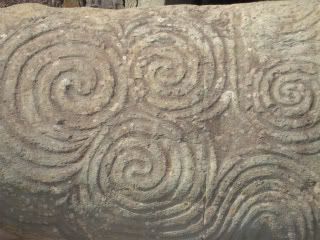19 de Mhí na Márta
I appear to be chiming in a bit late (as usual with these things), but am still striking off of an appropriate note as I'm enjoying my public holiday off of work since St. Paddy's fell on a Saturday this year. Around this time generally everything "Irish" appears in all sorts of headlines, and current news topics. Aside from the general stigma attached to American celebration of the day in the States chalk full of false stereo-types, that can even qualify as racism&discrimination, leading the boozefest in a general day ignorant of anything relating to actual Irish culture. I understand this pretty well coming from a city that has such big "Irish-American" festivities for it, and yes, was part of the sub-culture I was raised with.
This is however nothing new to me, but my current focus is the way the day is treated within "pagan" communities. The same sort of disassociation that you may see among the native&secular Irish, you also find within the pagan community, especially those following "Celtic" paths. The big reasons are usually for one, despite the normal piss up of a celebration with sin and debauchery, the festival is a primarily Christian religious one in origin. Going deeper, the feast day of Ireland's patron saint happens to be the saint most linked to the Christianisation of Ireland, not something your typical pagan would want to celebrate eh? We've all heard the modern lore of good auld St. Paddy driving the "snakes" from the island, snakes of course assumed to be a metaphor for either the general pagan inhabitants, or druids, but history is a funny creature in itself. Actual events, supposed events, and our understanding of them are often distorted, so if we're going to adopt such serious attitudes towards popular celebrations in modern culture, I guess it would be wise to at least understand them.
First of all. St. Paddy wasn't the first Christian, or missionary in Ireland. The first known Bishop was Palladius. It's important to understand Ireland's conversion to Christianity was relatively embraced and peaceful to a certain extent. The pseudo-history in the hagiographies featuring Patrick in "magical combat" with druids are likely made up to resemble Biblical stories like that of Simon Magus, but of course in the guise of encouraging belief in Christ. We actually owe a debt of gratitude to the church for recording our myths, which even though monks re-worked with their own twist, made it possible for them not to be lost in time. In regards to myths, other than the two main early sources we have of St. Patrick, mainly his Confessio, and letter to the soldiers of Coroticus, it's a possibility the man as we know him may not have even existed.
Now the "Snakes" right? It is well known there have never been snakes in Ireland. Either they didn't survive the last Ice age, or didn't have the right environment to migrate when there was a land-brdge. The whole bit of lore with Paddy&snakes was written by Anglo-Normans in the Middle ages. It was stated in some of his earlier biographies that he studied at the Lérin's monastery off the south coast of France founded by St. Honoratus, who was said to have banished all the snakes from Aralanensis. The Anglo-Norman writers must have liked that association, and since there were pre-existing tales of Paddy banishing demon-birds, and monsters into lakes, they penciled that one in under him as well. His role as a missionary in Ireland, and lore involving supposed encounters with druids likely lead to the symbolic association of pagans&snakes in modern folklore, but we do in fact know that the last pagan High-King in Ireland to be sworn in under the ban-feis rite at Tara, Diarmait mac Cerbaill, did so well over 100 years after Paddy's death in the 6th century, and pre-christian religious practices would have taken longer to wane generally from then.
Therefore if "All Snakes Day" is taking the piss out of modern folklore, then fair play to it, but there shouldn't be any more need in the pagan community to disassociate with the secular celebration of the day. If anything the stereo-types alone would make more sense in reducing an island with the second oldest vernacular in Europe, had a church that lead the rest of Europe throughout the Dark Ages, and has given such beauty, music, and amazing poets&literature to the rest of the world as a need for lack of acknowledgment. The day can also be seen as one of national pride, or by the diaspora as one to honour those that left their home, family, and language behind in order to face oppression& discrimination in becoming "Good Americans." That has usually been the case for me, so on that note, Lá Fhéile Phádraig shona daoibh!
Monday, 19 March 2012
Saturday, 11 February 2012
Féile Bríd
Dé Sathairn 11 de Mhí Feabhra 2012
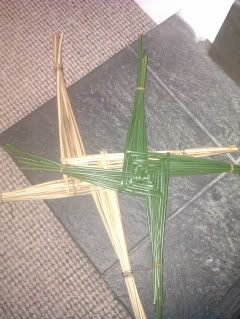
Bhuel Lá Fhéile Bríd go déanach! I've been meaning to get something up earlier for this(as well as many other things that succumb to internet procrastination, but found the right wee bit of time being an early morning Saturday insomniac. I was going to create a post called "Christian Appropriation" to explore common debates aroound this time such as syncretic Christian iconography adopted into Pagan practices, but perhaps that'll do for another time. In the mean time, thought I'd share something I had written before in spirit of the occasion.
Brighid, Briganti, Brigit, Briga, e.t.c is a Celtic Goddess, and Irish Saint, whose parallel comes up frequently in topics focused on Paganism and Christianity. That parallel is what I intend to focus on, so just briefly touching on the nature of this Goddess...
The etymology of her name literally means "exalted one", a pseudonym that Celtic inhabitants around high hills used for their mother-goddess.(Briganti) This Goddess was the sovereign Goddess said to give her name to Britain, and the famed tribe that controlled central Britain based around the Pennine Hills called the Brigantes, with Briganti their principal Goddess. Off-shoots of this tribe settled in the south-east of Ireland around the 1st century A.D. Many scholars believe that her cult was brought to Ireland with these settlements, with Brigit (Brighid) being her Irish adaptation.
In the myths and literacy creations, Brighid is a Poetess of the Tuatha Dé Dannan, and daughter of the Daghdha, with two sisters of the same name. She was a guardian-goddess of domestic animals, and patroness of smithcraft and poetry. A 9th century glossarian wrote that, "among all the Irish, a goddess used to be called Brigit." A few Irish rivers were given the name Brighid, along with many hills called Brí. It was said that Brigh was the first to weep and shreik to the dead, being a defender of the Laigin(Leinster), terrifying enemies appropriate for a territorial sovern goddess. This indicates that like Danu and Mór-Ríoghain, Brighid was another aspect of the mother-goddess in Ireland.
St. Brighid, Brigit, Bríd, of the Fotharta, Mary of the Irish/ Muire na nGael, is an Irish saint reputed to have lived C. AD 439-524, however practically nothing historical is known about her. Her cult had political importance with the rise of the Uí Dhúnlaige Leinster sept, so a Latin biography called Vita Brigitae was written in 650 by a cleric under the pen name Cogitosus.A shocking feature to many scholars about the text is the lack of any historical information about Brighid who supposedly lived a century earlier. It's mostly composed of miracles such as multiplying crops&stock, healing the sick, and even changing the weather(akin to rumoured feats of druids, and prayers to the Goddess Brighid) and the importance of Kildare. Not only does the saint share her name with the Goddess Brighid, but it's highly coincidental that her feast day, Lá Fhéile Bhríd, falls on the same date as Oímelc(Imbolg), the pagan festival of spring and turning point of the Celtic year, also connected with the goddess. Oímelg is taken to mean "in the belly", connected with lactation, and ewes milk. Is associated with the birth of farm animals in which the saint and goddess also happen to be patronesses of.
Kildare itself, Irish Cill Dara, means "Church of the Oak tree." This suggests that the site was a sacred pagan one, by the presence of oak groves sacred to the people we now refer to as "druids", and some accounts even state Brighid was the daughter of a druid. As F.J Byrne stated in Irish Kings&High-Kings, It's sceptical to doubt the existence of an actual Christian Saint of Kildare, but it's likely that a holy woman of the Fotharta Christianised a pagan sanctuary at Kildare, and borne the name Brighid, common among druidresses. The synthesis between Paganism and Christianity would have met less resistance under the name of Brighid, and much of Saint Brighid's lore contains elements of druidic practices keen for Christian propaganda. It's widely believed that the goddess's presence in the Gaelic mind was so strong, she was simply canonised as a saint.
Her cult was prominent in Leinster, and south Ulster, especially in Kildare and Faughart(where some sources even claim to be her birth), and much of her lore even spread to Scotland and Wales. Kildare and Faughart are still rich with her lore. Folk customs, especially on Febrary 1st like solar&St. Bríde's crosses (cróssog na Bríd), maintain lines to the Goddess Brighis, and well as being the feast of the Saint. Outdoor shrines, especially around sacred spriongs, as well as offerings and well dressings are all remnants of Ireland's pagan past, and living traditions of both Pagan and Christian Gaelic Traditionalists, as you can see here in the pics we took of her shrine at Faughart, Co. Louth...
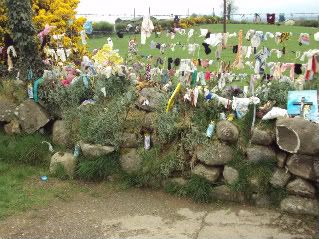
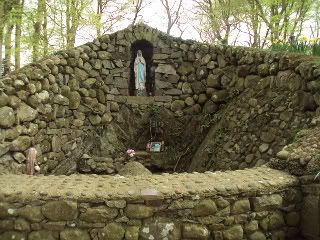
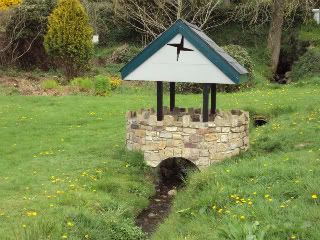

Bhuel Lá Fhéile Bríd go déanach! I've been meaning to get something up earlier for this(as well as many other things that succumb to internet procrastination, but found the right wee bit of time being an early morning Saturday insomniac. I was going to create a post called "Christian Appropriation" to explore common debates aroound this time such as syncretic Christian iconography adopted into Pagan practices, but perhaps that'll do for another time. In the mean time, thought I'd share something I had written before in spirit of the occasion.
Brighid, Briganti, Brigit, Briga, e.t.c is a Celtic Goddess, and Irish Saint, whose parallel comes up frequently in topics focused on Paganism and Christianity. That parallel is what I intend to focus on, so just briefly touching on the nature of this Goddess...
The etymology of her name literally means "exalted one", a pseudonym that Celtic inhabitants around high hills used for their mother-goddess.(Briganti) This Goddess was the sovereign Goddess said to give her name to Britain, and the famed tribe that controlled central Britain based around the Pennine Hills called the Brigantes, with Briganti their principal Goddess. Off-shoots of this tribe settled in the south-east of Ireland around the 1st century A.D. Many scholars believe that her cult was brought to Ireland with these settlements, with Brigit (Brighid) being her Irish adaptation.
In the myths and literacy creations, Brighid is a Poetess of the Tuatha Dé Dannan, and daughter of the Daghdha, with two sisters of the same name. She was a guardian-goddess of domestic animals, and patroness of smithcraft and poetry. A 9th century glossarian wrote that, "among all the Irish, a goddess used to be called Brigit." A few Irish rivers were given the name Brighid, along with many hills called Brí. It was said that Brigh was the first to weep and shreik to the dead, being a defender of the Laigin(Leinster), terrifying enemies appropriate for a territorial sovern goddess. This indicates that like Danu and Mór-Ríoghain, Brighid was another aspect of the mother-goddess in Ireland.
St. Brighid, Brigit, Bríd, of the Fotharta, Mary of the Irish/ Muire na nGael, is an Irish saint reputed to have lived C. AD 439-524, however practically nothing historical is known about her. Her cult had political importance with the rise of the Uí Dhúnlaige Leinster sept, so a Latin biography called Vita Brigitae was written in 650 by a cleric under the pen name Cogitosus.A shocking feature to many scholars about the text is the lack of any historical information about Brighid who supposedly lived a century earlier. It's mostly composed of miracles such as multiplying crops&stock, healing the sick, and even changing the weather(akin to rumoured feats of druids, and prayers to the Goddess Brighid) and the importance of Kildare. Not only does the saint share her name with the Goddess Brighid, but it's highly coincidental that her feast day, Lá Fhéile Bhríd, falls on the same date as Oímelc(Imbolg), the pagan festival of spring and turning point of the Celtic year, also connected with the goddess. Oímelg is taken to mean "in the belly", connected with lactation, and ewes milk. Is associated with the birth of farm animals in which the saint and goddess also happen to be patronesses of.
Kildare itself, Irish Cill Dara, means "Church of the Oak tree." This suggests that the site was a sacred pagan one, by the presence of oak groves sacred to the people we now refer to as "druids", and some accounts even state Brighid was the daughter of a druid. As F.J Byrne stated in Irish Kings&High-Kings, It's sceptical to doubt the existence of an actual Christian Saint of Kildare, but it's likely that a holy woman of the Fotharta Christianised a pagan sanctuary at Kildare, and borne the name Brighid, common among druidresses. The synthesis between Paganism and Christianity would have met less resistance under the name of Brighid, and much of Saint Brighid's lore contains elements of druidic practices keen for Christian propaganda. It's widely believed that the goddess's presence in the Gaelic mind was so strong, she was simply canonised as a saint.
Her cult was prominent in Leinster, and south Ulster, especially in Kildare and Faughart(where some sources even claim to be her birth), and much of her lore even spread to Scotland and Wales. Kildare and Faughart are still rich with her lore. Folk customs, especially on Febrary 1st like solar&St. Bríde's crosses (cróssog na Bríd), maintain lines to the Goddess Brighis, and well as being the feast of the Saint. Outdoor shrines, especially around sacred spriongs, as well as offerings and well dressings are all remnants of Ireland's pagan past, and living traditions of both Pagan and Christian Gaelic Traditionalists, as you can see here in the pics we took of her shrine at Faughart, Co. Louth...



Subscribe to:
Posts (Atom)
